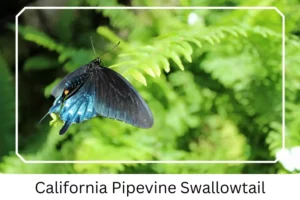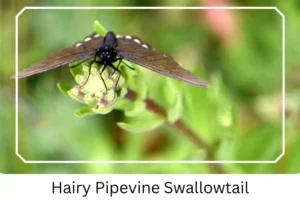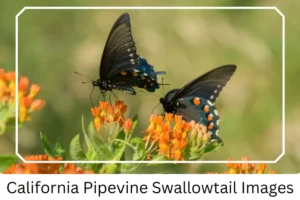California Pipevine Swallowtail (Battus philenor hirsute)
The California Pipevine Swallowtail, a distinct subspecies of the Pipevine Swallowtail, is a unique butterfly native to Northern California, USA. Known for its striking colors and specific habitat preferences, this species plays a significant role in the region’s biodiversity.
Scientific Classification
- Family: Papilionidae
- Genus: Battus
- Common names: Hairy Pipevine Swallowtail
- Scientific Name: Battus philenor hirsute
Overview
The California Pipevine Swallowtail thrives in the temperate forests of Northern California, closely associated with its namesake host plant, the California pipevine. This butterfly’s life cycle, from egg to adult, is a fascinating journey of transformation, showcasing nature’s intricate designs. Through conservation efforts, including habitat restoration, the species has seen a gradual resurgence, highlighting the importance of ecological balance and the impact of dedicated conservation work.
Description and Identification
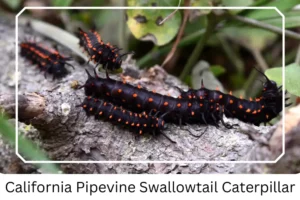 Caterpillar
Caterpillar
The caterpillar stage of the California Pipevine Swallowtail is notable for its black color, adorned with a distinctive fleshy lump and red spots across its body. This appearance serves as a warning to potential predators about its toxic nature.
Pupa
Resembling the adult butterfly, the pupa can vary in color from brown to green, with a wing-like structure on its sides. This camouflage aids in its survival during this vulnerable stage.
Adult Butterfly
Sexual Dimorphism: Absent in this species, both males and females display similar markings and colors.
Color and Appearance: The adult butterfly’s wings, when open, reveal an iridescent greenish-blue hue with red spots, contrasting sharply with the predominantly black underside featuring orange and white spots when closed.
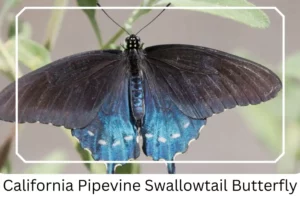
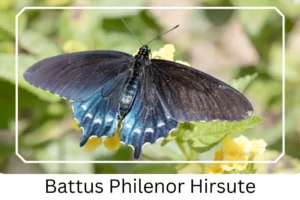 Average Wingspan: Ranging from 70mm to 130mm (2.75-5.11 inches), their size is slightly smaller than their parent species.
Average Wingspan: Ranging from 70mm to 130mm (2.75-5.11 inches), their size is slightly smaller than their parent species.
Flight Pattern: These butterflies are known for their fast and agile flight, which aids in evasion from predators and efficient foraging.
Eggs
The eggs of the California Pipevine Swallowtail are laid in significantly larger clutches than those of its species, indicating a strategic adaptation to increase survival rates.
Quick Facts | |
| Distribution | Found throughout Northern California, from the Sacramento Valley to Contra Costa and Alameda counties. |
| Habitat | Prefers warm, temperate forest areas near the California pipevine. |
| Lifespan of Adults | Ranges from 7 to 14 days. |
| Host Plants | Primarily the California pipevine. |
| Adult Diet | Consists of floral nectar from a variety of plants. |
How to Identify California Pipevine Swallowtail?
Identifying the California Pipevine Swallowtail involves noting its unique characteristics and behaviors. This butterfly’s smaller size, combined with its iridescent blue-green wings adorned with red spots, sets it apart from its relatives. The caterpillars are equally distinctive, with their black bodies and red markings signaling their toxic nature. Observing these butterflies near their host plant, the California pipevine, especially in the warm, temperate regions of Northern California, can also aid in identification. Their fast flight pattern and preference for floral nectar from a variety of plants further distinguish them, making them a fascinating subject for both amateur naturalists and professional entomologists.
Did You Know?
- Tim Wong, an aquatic biologist at the California Academy of Sciences, has been pivotal in the conservation of the California Pipevine Swallowtail by creating a butterfly sanctuary in his backyard. This initiative has contributed significantly to the species’ revival since 2017.
- The California pipevine, the primary food source for this butterfly, contains aristolochic acid, a potent toxin. This adaptation allows both the juvenile and adult butterflies to carry toxins in their tissues, providing them with a defense mechanism against predators.
- Despite their delicate appearance, these butterflies are adept survivors, with their flight speed and toxic nature deterring many would-be predators.
Conclusion
The California Pipevine Swallowtail is more than just a beautiful butterfly; it’s a symbol of nature’s resilience and complexity. Understanding and appreciating its lifecycle, behavior, and conservation can inspire further efforts to protect these remarkable creatures and their habitats. By fostering a deeper connection with our natural world, we ensure the preservation of such unique species for future generations to marvel at and learn from.
California Pipevine Swallowtail Pictures

Scientific Classification

- Family: Papilionidae
- Genus: Battus
- Common names: Hairy Pipevine Swallowtail
- Scientific Name: Battus philenor hirsute

